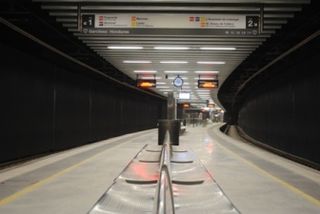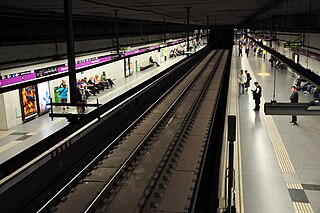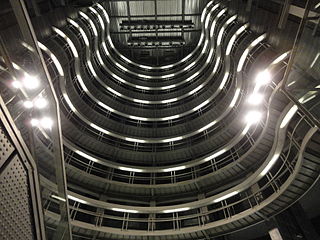
The Barcelona Metro is a network of rapid transit electrified railway lines that run mostly underground in central Barcelona and into the city's suburbs. It is part of the larger public transport system of Barcelona, the capital of Catalonia, Spain, with unified fares under the Autoritat del Transport Metropolità (ATM) scheme. As of 2014, the network is operated by two separate companies: Transports Metropolitans de Barcelona (TMB) and Ferrocarrils de la Generalitat de Catalunya (FGC). It is made up of 12 lines, combining the lines owned by the two companies. Two lines, L9 and L10, are being built at present, with both lines having different sections of each opened between 2009 and 2018. They are due to be fully completed in 2026. Three lines on the network have opened as automatic train operation/driverless vehicle systems since 2009: Line 11, Line 9 and Line 10, in chronological order.

Passeig de Gràcia ) is an underground railway and metro station in Barcelona located under Passeig de Gràcia, in Eixample district. It is one of the Barcelona's busiest railway stations and important stop for Barcelona Metro network. It is served by Rodalies de Catalunya suburban railway lines R2 and regional lines R11, R13, R14, R15 and R16, and it is also served by TMB-operated Barcelona Metro lines L2, L3 and L4.

Line 9 is a completely automated line of the Barcelona Metro network that is currently under construction, with 24 stations open in Barcelona and El Prat de Llobregat, L'Hospitalet de Llobregat, Badalona and Santa Coloma de Gramenet suburbs, since December 2009. The line is currently disconnected in two branches, with a connecting part between the two yet to be built. The Aeroport T1 – Zona Universitària section is called L9 South, and the La Sagrera – Can Zam portion L9 North. Upon completion, it will be the longest underground metro line in Europe.

Plaça d'Espanya, also simply known as Espanya, is an interchange complex underneath Plaça d'Espanya, in the Barcelona district of Sants-Montjuïc, in Catalonia, Spain. It comprises the Barcelona terminus of the Llobregat–Anoia Line and a Barcelona Metro station complex served by lines 1 (L1) and 3 (L3). On the L1, the station is between Hostafrancs and Rocafort, and on the L3 it is between Poble Sec and Tarragona. The Llobregat–Anoia Line station is served by Barcelona Metro line 8 (L8), Baix Llobregat Metro lines S33, S4 and S8, and commuter rail lines R5, R6, R50 and R60. The services on the Llobregat–Anoia Line are operated by Ferrocarrils de la Generalitat de Catalunya (FGC), whilst the L1 and L3 are operated by Transports Metropolitans de Barcelona (TMB).

La Sagrera-Meridiana, simply known as La Sagrera, is an interchange complex underneath Avinguda Meridiana, in the Barcelona district of Sant Andreu, in Catalonia, Spain. It consists of a Rodalies de Catalunya station and three Barcelona Metro stations. The Rodalies de Catalunya station is located in the Meridiana Tunnel on the Lleida to Barcelona via Manresa railway, between Sant Andreu Arenal and Arc de Triomf, and is operated by Renfe Operadora. It is served by Barcelona commuter rail service lines R3 and R4, as well as regional rail line R12. The Barcelona Metro stations are on lines 1 (L1) and 5 (L5), as well as the northern section of line 9/10, and are operated by Transports Metropolitans de Barcelona (TMB). On the L1, the station is between Navas and Fabra i Puig, on the L5 between Camp de l'Arpa and Congrés, and on the L9/L10 between Plaça Maragall (future) and Sagrera - TAV. The station is also projected to become the terminus of the L4 once the extension from La Pau opens. A number of interurban bus services stop near the station.

Sagrera railway station is a major through station under construction in the Barcelona districts of Sant Andreu and Sant Martí, in Catalonia, Spain. It is intended to serve as the central station for northern and eastern Barcelona, with Sants serving as the central station for southern and western Barcelona. Together with El Prat de Llobregat and Sants, currently the only high-speed rail stations in the Barcelona area, it will be on the Madrid–Barcelona high-speed rail line. It will also be on the conventional Barcelona–Cerbère and Barcelona–Mataró–Maçanet-Massanes railways. Once fully completed, it will be a major public transport hub, with dedicated stations on Barcelona Metro lines 4 and 9/10, as well as a bus station. The complex will be fully underground excepting for the station building, with two levels of platforms, accounting for a total of 18 railway tracks.

Sagrada Família is a metro station in Barcelona Metro network. It is named after the famous, and adjacent, Basílica i Temple Expiatori de la Sagrada Família, a church first designed by architect Antoni Gaudí and still under construction. It is served by TMB-operated Barcelona Metro lines L2 and L5.

Line 10 is the name of one of the two branches of the Barcelona metro line 9, currently (2020) under construction and to be operated by TMB. Like Line 9 and Line 11, it will be an automatic train operation metro line.

Plaça de Catalunya station, also known as Barcelona-Plaça Catalunya, Plaça Catalunya or simply Catalunya is a major station complex in Barcelona located under Plaça de Catalunya, the city's central square and a large transport hub. Many Rodalies de Catalunya, Barcelona Metro and Ferrocarrils de la Generalitat de Catalunya lines go through it and many bus routes link it with all of the districts of the city and most of the municipalities in its metropolitan area.

Sarrià is a railway station located under the Via Augusta at Carrer de l'Hort de la Vila in the Sarrià neighbourhood of the Sarrià-Sant Gervasi district of Barcelona. It is served by lines L6 and L12 of the Barcelona Metro, and by lines S1, S2, S5, S6 and S7 of the Metro del Vallès commuter rail system. All these lines are operated by Ferrocarrils de la Generalitat de Catalunya, who also run the station.

Gorg is a Barcelona Metro and Trambesòs complex named after the neighbourhood of the same name where the station is situated, in Badalona municipality. It is located on Avinguda del Marquès de Mont-Roig and very close to Palau Municipal d'Esports de Badalona, the home arena of the professional basketball club Joventut de Badalona. It is served by TMB-operated Barcelona Metro lines L2 and L10, and Trambesòs route T5.

Avinguda Carrilet, also known as L'Hospitalet Avinguda Carrilet, is an interchange complex underneath Avinguda Carrilet in the L'Hospitalet de Llobregat municipality, to the south-west of Barcelona, in Catalonia, Spain. It consists of a railway station on the Llobregat–Anoia Line and a Barcelona Metro line 1 (L1) station. The Llobregat–Anoia Line station is served by Barcelona Metro line 8 (L8), Baix Llobregat Metro lines S33, S4 and S8, and commuter rail lines R5, R6, R50 and R60. The services on the Llobregat–Anoia Line are operated by Ferrocarrils de la Generalitat de Catalunya (FGC), whilst the L1 is operated by Transports Metropolitans de Barcelona (TMB).

Airport T2 is both a Rodalies de Catalunya commuter rail station and a Barcelona Metro station serving terminal complex T2 of Barcelona–El Prat Airport. They are located adjacent to the airport's terminal T2B, in the municipality of El Prat de Llobregat, to the southwest of Barcelona, in Catalonia, Spain. The Rodalies de Catalunya station is the southern terminus of the current rail link coming from El Prat de Llobregat railway station. It is operated by Renfe Operadora and is served by Barcelona commuter rail service line R2 Nord. The metro station is on the airport branch of Barcelona Metro line 9 (L9) and is operated by Transports Metropolitans de Barcelona (TMB).

Rail transport in Catalonia operates on three rail gauges and services are operated by a variety of public operators:
Public transport in Barcelona is operated by several companies, most of which are part of the Autoritat del Transport Metropolità, a transport authority managing services in the Barcelonès and the rest of the metropolitan area of Barcelona. This article is a summary with transport facilities and services strictly within the municipality of Barcelona, and contains links to more specific articles.

Can Peixauet is the name of a Barcelona Metro line 9 station named after Avinguda de Can Peixauet, situated in Santa Coloma de Gramenet municipality.

Onze de Setembre is a Barcelona Metro station named after Rambla Onze de Setembre, one of the main streets in the neighbourhood of Sant Andreu de Palomar where it is located, part of Barcelona's district of Sant Andreu. It was opened with the opening of the L9/L10 section between Bon Pastor and La Sagrera stations on 26 June 2010. It is served by TMB-operated Barcelona Metro lines L9 and L10.

La Salut is a Barcelona Metro station named after the neighbourhood of the same name where the station is situated, in Badalona municipality. It was opened on 18 April 2010 with the opening of the line from Gorg to Bon Pastor. It is served by TMB-operated Barcelona Metro line L10.

Llefià is a Barcelona Metro station named after the neighbourhood of the same name where the station is situated, near Llefià Market, in Badalona municipality. This neighbourhood is one of Badalona's with highest population density and built in a very uneven piece of land. The station was opened on 18 April 2010 with the opening of the line from Gorg to Bon Pastor. It is served by TMB-operated Barcelona Metro line L10.






















